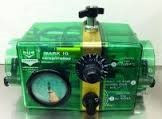When the patient made an inspiratory effort a green colored machine called a Bird ram-rodded more air into their lungs. There were literally flocks of these Birds everywhere, jamming the elevators and flying down the halls. A savvy inhalation therapist could tether a bunch of them together and pull them along like a train.
This is a bird. These things were originally designed to be pressure limited ventilators and were used as such for a long time. I remember old Marcus Welby and Emergency TV shows that featured their use. When used as a ventilator they would cycle off after reaching a certain pressure. When the Puritan Bennet MA-1 was introduced in about 1970, these Birds gradually became extinct as ventilators. With the MA-1, volume limited ventilation ruled the roost because they always delivered the same tidal volume with each cycle.
I am just guessing, but this might be a reason IPPB became so popular. These Birds were just sitting around inhalation therapy departments looking for a place to roost. Some of the empirical reasons for IPPB was the notion that it could clear the anesthesia out of the lungs post op and prevent atelectasis. Just about every MD had a different rationale for using IPPB. I remember one surgeon always wrote a post op order for inhalation therapy to DYT (do your thing)
Post op patients hated IPPB. Just imagine having a big abdominal incision and having a machine not under your control stretch the daylights out of it. Not a pleasant experience. I remember patients letting air leak out around the mouthpiece during inspiration to ease the painful chest excursion and the inhalation therapist threatening to restrain their hands and use a mask on them. This was a time when healthcare workers told patients what was best for them whether they liked it or not.
When hospitals had to pay inhalation therapists more than $3.50 per hour (the 1970 wage), the cost of IPPB began to climb and insurance carriers began to question the value of IPPB. When actual study and science was applied to IPPB it lost support. Studies showed it had no benefit and actually had negative consequences such as decreasing cardiac output and triggering arrhythmias.
I wonder what became of all those Bird machines. I imagine they would make great aerators for a fish farm in some third world country. More likely, they are just sitting around somewhere. It always amazes me how fast something that was so common and popular could simply disappear. I wonder what modalities of treatment in use today will wind up in the trash heap tomorrow.

Cripes. I'm a RRT at an LTACH hospital. Our chief of staff is old, old school and likes to order IPPB for people with increased secretions. Hello! They have increased secretions because they are barely lucid and won't cough worth a flip. How 'bout some NT suctioning and maybe some bipap. Cripes. We still have 3 of these Bird Mark 7's wandering around, but only two of them work properly.
ReplyDeleteBack in the day it seems IPPB was a cure for everything. My favorite rationale was to "clear out the anesthesia" post op. Never mind that halogenated anesthetics were fat soluble! It's impressive that you still have your mini flock of Birds. I figured that they have all flown south by now. Thank you for taking the time to comment.
ReplyDeleteHi ~ new to your blog from Dr. Grumpy's. I love it!
ReplyDeleteI remember IPPBs, too. There was one always in the way; either at the nurses station, or in a pts room ~
We even had the old oscilliscope EKG monitors!
Off to read more ~
Another retired RN